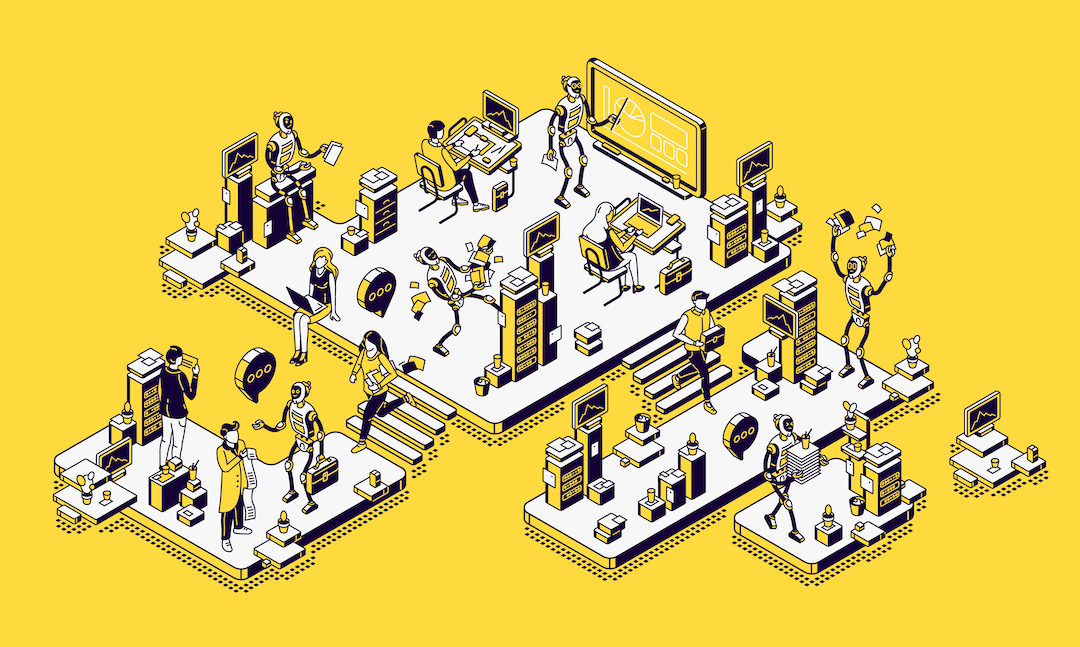New year, new fortune, new work? In 2020, we have witnessed a number of changes in the world of work: more working from home, remote working, homeschooling, and virtual presence. In this context, are we still able to envision trends for the future of work in 2021?
This was the question we addressed at the first New Work Berlin Meetup in 2021. When looking ahead, participants naturally also draw on past experiences. For this reason, in the first part of this article, you will learn about the relevant insights and innovations of the past year. In the second part, we present the New Work Trends of 2021. If you’re now asking yourself, “What is New Work, anyway?”, we invite you to learn about the top 25 Future of Work topics. The article gives a good introduction to the subject.
Future of Work 2020 – a look back
2020, what a year! At the New Work Berlin Meetup in January last year, it was all about anti-trends. In the sense of: How can you really effectively prevent the new world of work? At that time, this question was answered in a socially non-distanced manner and in a very entertaining way, for example with spontaneous acting interludes by individual small groups. It’s like a flashback to another time. Interestingly, there was no mention of working from home or remote work back then, but rather suggestions in the direction of communication and employee-centeredness.
What has changed in 2020
The real 2020 has probably had an impact on all of us. More than we might have guessed and could have foreseen in January 2020. The following observations, opinions and experiences were expressed by the participants in response to the opening question.

Ergonomics also play an important role in the home office. Working without the right equipment can quickly lead to back pain. Picture by Andrew Neel.
Covid – a success story for working from home
- Working from home & flexibility in working hours was a topic every now and then before, but also in many companies still afflicted with the attitude “that’s not possible”.
- Covid showed us how willing people are to change and adapt when they suddenly switch to working from home.
- Productivity has actually not dropped in many areas.
- Sick leave has dropped significantly (is that actually good or bad?!).
Covid shows the challenges when working from home
- In the long run, working from home doesn’t provide enough social exchange. Not everything is just great – but that’s what many thought before Covid.
- Initially, initiatives like Chat Roulette were successful, Virtual Coffees and the like were introduced. However, there was a lot of fatigue here over the course of the year.
- The separation of work and leisure time became more difficult due to remote work and as a result, it is often difficult to unwind after work.
- The question arises: How do I organize my working hours and my workplace in my home?
What comes after Covid?
- Work location: some people demand working from home as the norm, others prefer to go back to the office – how can this be combined and/or managed?
- Do all the people who have been hired in the meantime still fit into the office at all? Or, conversely, has the office perhaps become far too big?
- Will we ever travel again for small meetings and get-togethers?
Further observations and changes
- There have been mind-blowing and radical changes, especially for sole proprietors and freelancers who lack the security of a corporate structure.
- In many areas, digital solutions suddenly become possible where it previously was unthinkable (for example team events).
- Many professions and jobs in certain industries have completely disappeared, such as the event industry or gastronomy. This has caused people to reorient themselves.
- When it is suddenly a matter of existence, people also pay attention to what is really important. Unfortunately, futuristic work methods were sometimes seen as a luxury topic when it wasn’t clear whether they really serve a sustainable purpose.
- Conversations about digitization are heavily dominated by startups and large companies. In between, there are many medium-sized companies that are not even aware of the possibilities of digitization, for example for decentralized production processes at machine builders.
- Large home office fans also lack social exchange. At the same time, the working world has somehow become more personal, e.g., by seeing the living room of colleagues in video calls, or children running through the camera. In addition, the question “How are you doing?” has taken on a completely different meaning. There’s more openness to admit that you’re not feeling well – even if you don’t really know each other that well.
Here are the 2021 future of work trends
There are participants of all stripes in the New Work community. That’s why we found it very exciting to record the different predictions for this year. They reflect the various challenges of individual industries and professions. Time will tell whether these are pious hopes or will become reality.
We will put more attention to the social component of work

In the future, offices may serve mainly as meeting places for teamwork. Picture by fauxels
- We will mutually accept our individual rhythm (e.g. when am I productive, when am I not?), even if this may mean less overlapping time with colleagues.
- We will expand our own ability to self-organize, be more mindful of ourselves, and not (let ourselves be) overwhelmed (anymore).
- We will trust each other more to do a good job, and at the same time have understanding and compassion for how people are doing.
- We will pay attention to social exchange, for example obligatory regular intensive team meetings. Otherwise, each person can work off tasks where and when one wants and thus enjoy more flexibility.
- We will pay attention to the social and human challenges of the hybrid work model, when at some point people are back in the office and others continue to work remotely.
We will experience agility as the new reality
- The agile working method (“driving on sight”) is becoming a standard work component. Long-term planning tends to become the exception. At the same time, we will put more emphasis on the vision and purpose of the work. (See also the article on purpose).
- Being able to adapt quickly to changing situations, again and again, is encouraged instead of rigidly sticking to plans.
- Acceptance of modern ways of working and agility will increase. It’s okay that not everything can be predicted 100% and it’s also okay if plans have to be completely thrown out the window.
- The tolerance for failure is on the rise and we are constantly learning. (See also the article on new learning from October 2020).
We will continue to use the possibilities of digital solutions
- The coordination of work is becoming even more digital and data-driven. This also offers the opportunity to simplify participation through digital tools, make work processes more transparent, and learn from the past.
- In doing so, we are guided by the questions: “How do we work together?” and “How can we personalize and individualize the work environment?”
We will use human networks even more intensively
- We will exchange more about new forms of work and inspire each other on how work can be improved. In doing so, we will use the informal network with our colleagues.
- Companies are promoting “referral programs” even more strongly in order to find new employees, i.e. companies incentivize their own employees to recruit new colleagues from their network.
Our conclusion
In 2020, we learned a lot about spontaneous change, planning uncertainty, our own flexibility and vulnerability. It seems as if we will not go back to the “old normal” in 2021 either. Rather, our working world will change even further due to Covid. Nevertheless, we will try to reclaim human proximity wherever it is possible. Certainly, we can consider ourselves lucky that digital tools made it possible for many people to pursue their work despite a global pandemic. The negative effects, such as social isolation, and their consequences will continue to concern us in the future. We all miss the real human encounters, in our private and working lives, and in the New Work community. We all hope for a lot of optimism, solidarity, creativity and visionary power. In this way, despite all the circumstances, we can already positively shape the future of work today as suggested in the four future of work trends above.
Our guest authors

Jens Hündling – Foto von studioafraz.com
Jens Hündling is a freelance trainer and coach for digital transformation and new work. As a former IT executive, he prefers to communicate with people rather than machines. Jens is passionate about developing teams and organizations. Especially with East Frisian humor. More about him at https://dr-huendling.de

Clarissa Napierski
Clarissa Napierski is a psychologist, business economist and Future of Work Facilitator. In recent years, she has driven the setup of modern HR work and accompanied organizational development in startups as well as medium-sized companies. Recently, Clarissa has also started working as a freelance trainer for team and HR development.
Title picture by Freepik


